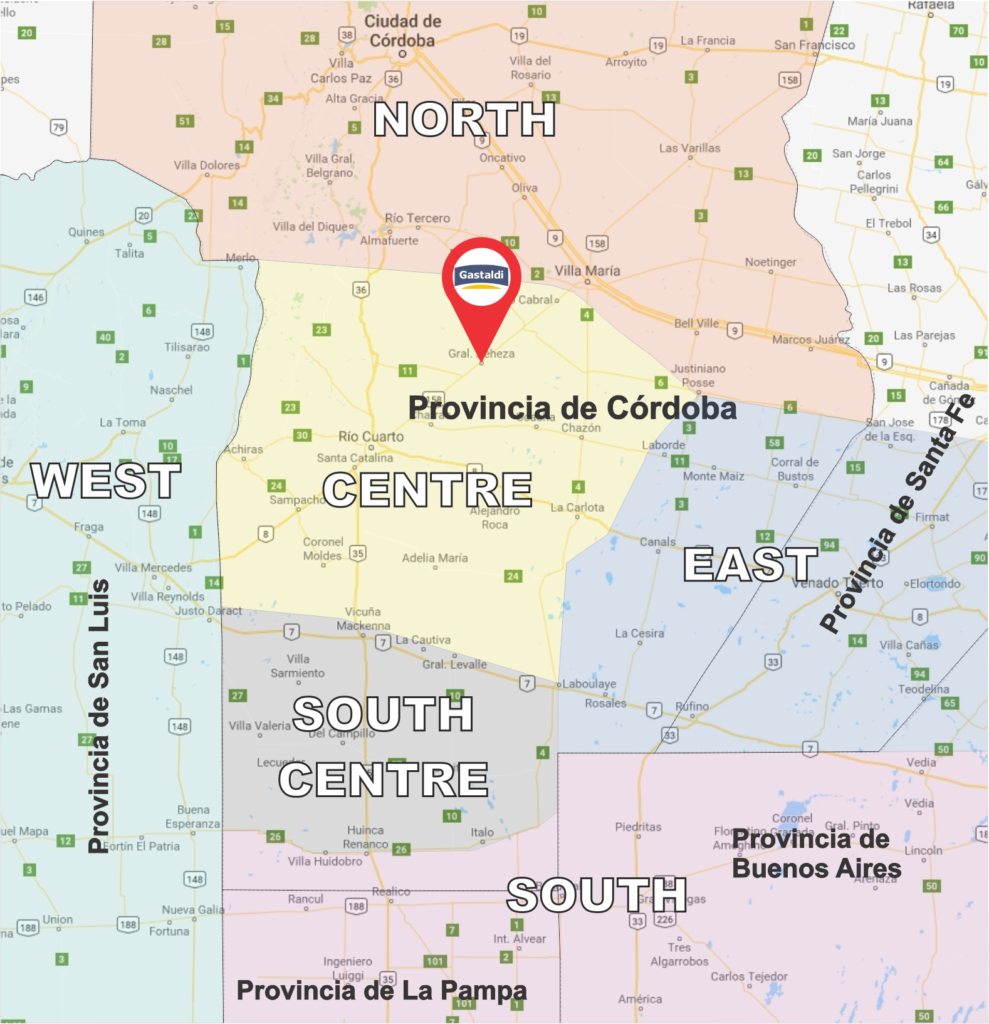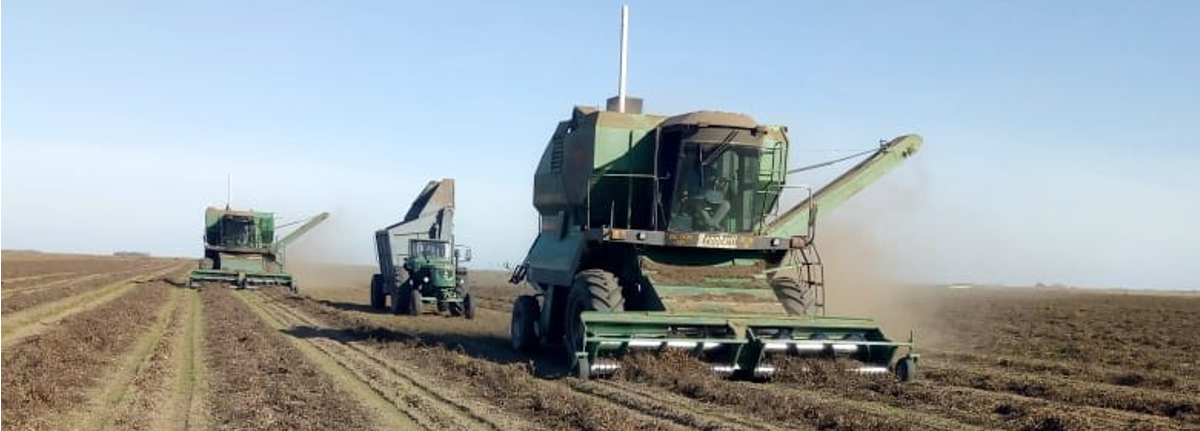Crop Evolution Report
June 13th, 2019
Peanuts from Argentina
General Overview
In general terms, we report that the peanuts from Argentina maintains good prospects in terms of yield and quality, as we enter the final stretch of the season. Although the current condition of the peanut crop is variable according to the geographical area, a very good development is observed in general, in spite of adverse climatic conditions suffered in the last weeks.
The inverted-digging tasks can now be considered as totally concluded, while the harvesting tasks show progress of 24% with respect to the total planted area, which represents a significant delay, compared to previous seasons. This delay is due to unstable conditions in the environment, mainly characterized by drizzle, fog and high humidity in general, which prevents the normal work of the combines or, in those cases where it is possible to work, the humidity of the harvested peanuts shows very high values, more than 20% in some cases. Therefore, the reception of in-shell peanuts in the shelling plants is hampered, given that artificial drying must be used on a large scale, which is a slow process that constitutes a clear bottleneck in production. As can be seen in the following graph, the average humidity of the peanuts at the reception stage has been very variable, in line with the unstable conditions reported.

Evolution in the humidity of the harvested peanuts received in the Gastaldi Hnos.’ shelling plant.
Although the environmental conditions are not adequate to move quickly in the fields, there were not intense and continuous rains, as it happened in the last two seasons. For this reason, despite the reported delay, the collected peanuts do not register significant damages that affect their commercial quality. In any case, the climatic conditions from now on will be of extreme importance to determine the characteristics of the peanuts that still need to be be harvested, which constitutes three quarters of the total expected peanuts for season 2018-2019. The following graph shows the distribution of peanuts in the reception stage, according to physical quality and aflatoxins. APS-1, 2 and 3 correspond to peanut without the presence of aflatoxins and constitutes 98% of what has been received so far.

Distribution of in-shell peanuts received to date, according to physical quality and aflatoxins
Regarding projected yields, there are large differences between peanut lots that suffered drought stress conditions during the end of January and part of February, compared to those that passed the growth cycle without major upsets. In addition, those lots that have suffered a marked incidence of soil diseases caused by Sclerotinia or Fusarium, also show a decrease in the projected yield. In any case, it is important to note that these conclusions must be taken with caution, given that the percentage of advance in the harvest is still very low. On the other hand, it is important to note that the losses generated at the time of harvest in the field are very low and highly inferior to previous years (except in those lots that present problems).
At the time of preparing this report, the agronomic team of Gastaldi considers that 65% of the harvest is in a very good or excellent state (vs. 75% reported last month):
Below, a detail of the general results:
• Excellent: 20% (vs. 30% reported the previous month)
• Very good: 45% (vs. 45% reported the previous month)
• Good: 25% (vs. 20% reported the previous month)
• Regular: 10% (vs. 5% reported the previous month)

Crop condition reported by the Gastaldi team of agronomists.
Main Area Map Peanuts from Argentina
The main peanut area in Argentina includes the provinces of Cordoba, La Pampa, San Luis and Buenos Aires. In general terms, it can be divided as follows:

Main peanut area map.
Agricultural and climatic condition
During May, rainfall was above the historical average of the last years. Although it was isolated rainfall and of mild to moderate intensity, they increased soil moisture levels. Considering that the peanut is at R8 maturity stage (full maturity), the absorption of water by the crop is almost nil, which generates complications at the time of harvesting.

Cumulative rains in the Cordoba province – May 2019
In addition, there were abundant days of fog and winds from the North. The progress is slow, given that the peanuts that could be harvested exhibit very high humidity levels (between 18% and 20%). Therefore, those peanuts must be artificially dried at the reception stage, generating a great delay in the transportation from the fields to the shelling plants, which are currently collapsed. In response to this problem, farmers from different areas decided to continue working when conditions allowed and to deposit the farmer stock on the ground in order not to stop the threshing. This situation is not usual and constitutes a risk since, if weather conditions worsen in the short term, the final quality of peanuts could be compromised.
Moving into June, although the conditions of instability continued, there were no records of significant rainfall along the peanut area.

Cummulative rains in the Cordoba province – June 1st to 12th, 2019
As for the thermal records, the minimum temperatures were lower than 12 °C in those cities located in the South and South-Western zones of the province of Cordoba, while the Southern area (La Pampa) had records close to 5 °C. The maximum temperatures did not exceed 24 °C.
Harvesting progress
As previously mentioned, the advance of harvest at the time of preparing this report amounts to 24% of the total planted area.

Harvesting progress as of 10-06-2019
Sunny and dry days are imperatively required to decrease the humidity of the peanuts in order to resume the expected pace of progress.
Agronomic problems and crop-related tasks
The high presence of winter weeds and cover crops in peanut lots also contributed to generate delays.
On the other hand, farmers and agronomists are currently carrying out grid work in the Northern, Central and Southern areas, mainly in those lots that are grounded and stuck to the ground. The grid is aimed to aerating the rows of peanuts, lowering the humidity of the grains and detaching the peanuts from the ground. Results are achieved quickly, since moisture in the peanut kernels fall between 2 and 3 moisture points in 48 hours.
Estimates of the Cordoba Grain Exchange (BCCBA)
The BCCBA has recently published a new estimate of the peanut crop in Argentina:
“In the peanut area, comprised by the provinces of Cordoba, San Luis, La Pampa and the northwest of Buenos Aires, a production of 1,316,500 tons is expected, which represents a 52% increase compared to the previous season 2017/2018. The average yield is 4.12 tons/hectare (dirty and wet in-shell peanut basis). The lost area amounts to 4,600 hectares due to rains that caused waterlogging, and to diseases such as Sclerotinia minor, Sclerotium rolfsii and Thecaphora frezii (smut) that negatively affect the stand of plants and the yield.”

Estimation of the peanut crop results for the 2018-2019 season
“From the total peanut area, 90% has been already dug, while the progress of harvest is 13%, the smallest figure in recent years, mainly due to the high levels of humidity.”

Estimation of the peanut crop results for the 2018-2019 season. * up to June 3rd, 2019.
Final Remarks
Despite the aforementioned delays in harvesting activities due to adverse weather conditions, progress continues, and expectations remain positive. It is essential to have a considerable window of good weather to be able to resume harvesting tasks in the fields without major problems and thus materialize the good projected yields. If there are no major climatic inconveniences, we estimate that the Argentine peanut crop should be entirely harvested in the next 8 weeks or so.
Images

Combines working in the Northern Area

Harvesting in the South-Central Area

Harvesting in the South-Central Area

Harvesting in the Eastern Area
Do you have a commercial inquiry?
Request for price quote
Other questions or comments?
Contact us: stembras@gastaldihnos.com.ar


